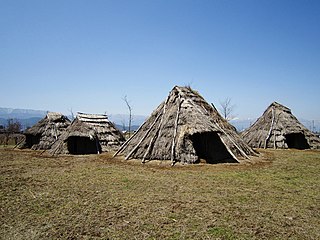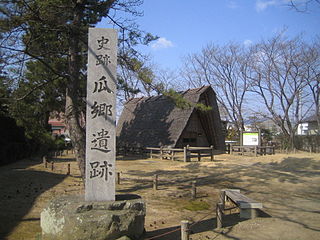
The Iwajuku site an archaeological site located in what is now the Kasuke neighborhood of the city of Midori, Gunma Prefecture in the northern Kantō region of Japan with finds from the Japanese Paleolithic period. It received protection as a National Historic Site in 1979.

Kofun are megalithic tombs or tumuli in Northeast Asia. Kofun were mainly constructed in the Japanese archipelago between the middle of the 3rd century to the early 7th century CE.

Mukibanda Yayoi Settlement Site is an archaeological site with a large Yayoi period settlement remains, straddling the border between the municipalities of Yonago] and Daisen, Tottori Prefecture in the San'in region of western Japan. The Mukibanda site was designated a National Historic Site in 1999.

The Ōzakai cave dwelling is an archaeological site consisting of a cave dwelling in the Ōzakai neighborhood of the city of Himi, Toyama Prefecture in the Hokuriku region of Japan. The site was designated a National Historic Site of Japan in 1986.

The Mawaki Site is an archaeological site with the ruins of a Jōmon period settlement in the Mawaki neighborhood of the city of Noto, Ishikawa in the Hokuriku region of Japan. The site was designated a National Historic Site of Japan in 1989.

Muroya Cave is an archaeological site consisting of a Jōmon period cave dwelling in the Kamiya neighborhood of the town of Aga, Niigata Prefecture in the Hokuriku region of Japan. The site was designated a National Historic Site of Japan in 1980.

The Hiraide ruins is a complex archaeological site containing the ruins of an early Jōmon period to early Heian period settlement located in the Soga neighborhood of the city of Shiojiri, Nagano in the Chūbu region of Japan. The site was designated a National Historic Site of Japan in 1952.

The Urigō ruins is an archaeological site containing the ruins of a Yayoi period settlement, located in what is now part of the city of Toyohashi, Aichi Prefecture in the Tōkai region of Japan. It was designated a National Historic Site of Japan in 1953.

The Shingū ruins archaeological site containing a ruins of a village complex which was inhabited from the late Jōmon period through the Kamakura period, located in the Shingū neighborhood of the city of Okazaki, Aichi in the Tōkai region of Japan. It was designated a National Historic Site of Japan in 1976.

The Iwaidō Caves is an archaeological site containing the ruins of a Jōmon period cave dwelling located in what is now part of the city of Yuzawa, Akita in the Tōhoku region of Japan. The site was designated a National Historic Site of Japan in 1978.

The Jizōden ruins is an archaeological site containing the ruins of a large-scale Yayoi period settlement located in what is now part of the city of Akita in the Tōhoku region of Japan. It also contains artifacts from the Jōmon period and the Japanese Paleolithic periods. The site was designated a National Historic Site of Japan in 1996. The site is maintained as an archaeological park with some reconstructed buildings.
Nakatakase Kannonyama Site is an archaeological site containing the ruins of a Yayoi period settlement located in what is now the city of Tomioka, Gunma Prefecture in the northern Kantō region of Japan. The site was designated a National Historic Site of Japan in 1997.
The Shimogō Site is an archaeological site containing the ruins of a Yayoi period fortified settlement, located in what is now part of the city of Moriyama, Shiga Prefecture in the Kansai region of Japan. It was designated a National Historic Site of Japan in 2002.
The Yotsuike site, is an archaeological site containing the remains of a Yayoi period settlement, located in the Otorikitamachi, Nishifunao-cho neighborhood of Nishi-ku, Sakai, Osaka Prefecture, Japan. It was designated as a National Historic Site in 1989, with the area under protection enlarged in 2001.

The Ikegami-Sone site is an archaeological site containing the ruins of a large-scale Yayoi period settlement straddling the Ikegami neighborhood in the city of Izumi and the Sone neighborhood in the city of Izumiōtsu in the Kansai region of Japan. It is a large settlement ruin with a total area of 600,000 m2, extending 1.5 kilometers north-to-south and 0.6 kilometers east-to-west. It was designated a National Historic Site of Japan in 197 and has been maintained as an archaeological park since 2005.

The Kusaka Shell Midden is an archaeological site in the Kusaka neighborhood of the city of Higashiōsaka, Osaka Prefecture, in the Kansai region of Japan containing a Jōmon period shell midden. It was designated a National Historic Site of Japan in 1972.

The Kamikuroiwaiwakage Site is an archaeological site consisting of a Jōmon period rock shelter dwelling in the Mikawa neighborhood of the typo of Kumakōgen, Ehime Prefecture in the island of Shikoku Japan. The site was designated a National Historic Site of Japan in 1971.
The Kamo site is an archaeological site with the traces of a Yayoi period settlement located in the Minamihanayashiki neighborhood of the city of Kawanishi, Hyōgo Prefecture, in the Kansai region of Japan. It was designated a National Historic Site in 2000.
The Aoki Site is an archaeological site with the traces of a late-Yayoi period to early-Nara period settlement located in the Nagae neighborhood of the city of Yonago, Tottori Prefecture, in the San'in region of Japan. It was designated a National Historic Site in 1978.

The Kadota Shell Mound is an archaeological site in the Oku neighborhood of the city of Setouchi, Okayama Prefecture, in the San'yō region of western Japan. It contains a shell midden and the traces of a prehistoric settlement, and was designated a National Historic Site of Japan in 1985.



















